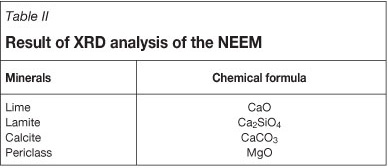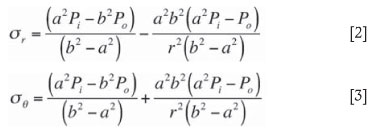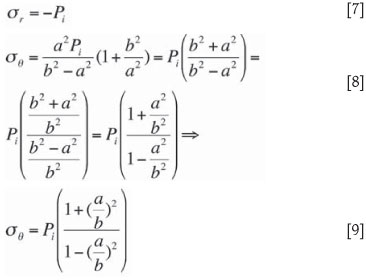Services on Demand
Article
Indicators
Related links
-
 Cited by Google
Cited by Google -
 Similars in Google
Similars in Google
Share
Journal of the Southern African Institute of Mining and Metallurgy
On-line version ISSN 2411-9717
Print version ISSN 2225-6253
J. S. Afr. Inst. Min. Metall. vol.112 n.7 Johannesburg Jul. 2012
JOURNAL PAPER
An experimental approach to determine the hole-pressure under expansion load
M. GholinejadI; Sh. ArshadnejadII
IDepartment of Mining Engineering, South Tehran Branch, Islamic Azad University, Iran
IIDepartment of Mining Engineering, Mahallat Branch, Islamic Azad University, Iran
SYNOPSIS
Applying non-explosive expansion material (NEEM) is one of the safest methods for rock fracturing, especially in a hard rock quarry. An experimental study was conducted to determine the pressure exerted by NEEM in a hole, which is necessary for analysing rock fracturing, particularly in a numerical modelling. Stress distribution was developed in a thick-wall cylinder in order to measure the tangential strain on the external boundary. In the experiments, nine pipes of different materials and varying diameters were selected and then loaded internally with a general type of NEEM. Through electrical strain gauges, the tangential strains were recorded on the external boundary of the pipes.
The results obtained from these tests and existing data from previous researchers were utilized for the statistical analysis. A new experimentally-derived formula is proposed for determining the pressure exerted by NEEM by multiple parameter regression with a high correlation coefficient. The proposed model has a nonlinear form with three independent parameters i.e. the hole diameter, the time, and the modulus of elasticity of the material.
Keywords: experimental test, non-explosive expansion material, thick-wall cylinder.
Introduction
Non-explosive fracturing of rocks is one of the main rock-breaking methods in hard rock quarries or for the demolition of any concrete structure, and is usually accomplished through the use of non-explosive expansion material (NEEM). Although this method of rock breaking is without noise or vibrations and the entire operation is controllable, safe, and easy, the process is lengthier compare to the blasting method. In this method, circular holes are drilled consecutively in a block of rock with equal length, diameter, and spacing (centre-to-centre distance). Subsequently, the holes are filled with NEEM in grouted form, which by its expansion generates an incremental static load into the holes after about two to four hours (Goto et al., 1988; Zhongzhe et al., 1988; Jana, 1991; Hayashi et al., 1994; Pal Roy, 2005). If the spacing of the holes is appropriate, this will create intersecting cracks between two neighbouring holes, and the block will fracture along the high-stress concentration path between the holes. However, if material is brittle (e. g. hard rocks such as granite and quartzite), it will neither yield fracture nor will elastic behavior be observed before its failure (Hoek and Bieniawski, 1965; Lajtai, 1972; Lawn and Wilshaw, 1975; Ingraffea and Schmidt, 1978; Fowell, 1995; Eberhardt et al., 1999; Orekhov and Zertsalov, 2001; Yagiz, 2009). In other words, stress distribution into the brittle material will be elastic until the fracture process is completed.
Prediction of rock fracture depends on the pressure in the hole, and this information is also required in the numerical modelling of crack growth. This investigation was aimed at determining the pressure developed in a hole due to expansion of the NEEM by physical modelling as well as developing an elasticity theory.
Non-explosive expansion material (NEEM)
The main reaction that takes place in the NEEM is the hydration of lime with evolution of heat:

Without confinement, the reaction results in a volume increase of about two times. Under confinement, the reaction rapidly generates an expansive pressure which exceeds the tensile strength of rocks (when the drill holes are charged with NEEM, the expansive pressure gradually increases to more than 20 MPa). Goto et al. (1988) investigated the reaction of NEEM in a steel pipe as well as its expansive pressure with respect the time (Figure 1) . Using a pressure sensor and strain gauge, they recorded data over 24 hours.

Mechanical behavior of the NEEM includes time, the modulus of elasticity of the rock or other material, and the diameter of the hole (Arshadnejad et al., 2010). NEEM is a chemical combination based on CaO (between 70 and 90 per cent) and SiO2, together with a few other substances such as Al2O3, Fe2O3 etc. Most NEEMs have the same chemical combination worldwide (Goto, et al., 1988; Soeda et al., 1988; Arshadnejad et al., 2010). The NEEM used in the present study was of Iranian manufacture, with the trade name Katrock. Tables I and II show the the chemical analysis (by XRD and XRF) for the NEEM.

Stress distribution around a hole due to internal load
The stress distribution around a circular hole depends on the stress field. Kirsch (1898) initially studied this problem for a single circular hole under a biaxial stress field. The field stress in the current study was located on the external boundaries.
The stress distribution within a thick-walled cylinder under a uniform external and internal load is as follows (Timoshenko and Goodier, 1951)

where ar and ae are the radial and tangential stresses respectively, and r is the radial distance of the considered point from the hole centre. Pi and Po are the internal and external pressures, and a and b are the internal and external radius of the thick-walled cylinder, respectively. Because of axisymmetry in the loading as well as body geometry, there is no shear stress in the medium. Following are some of the constraints for using thick-walled cylinder equations (Shigley, 1956; Hertzberg, 1996).

If there is no external pressure (P0 = 0) the equation becomes:

Stresses on the internal boundary (r = a) are a maximum as follow:

Stresses on the external boundary (r = b) will be as follows:

The tangential strain in the thick-walled cylinder is as follow:

where εθ is the tangential strain, E is Young's modulus, and v is Poisson's ratio. Since the radial stress on the external boundary is zero (Equation 10), the strain on the external boundary (r = b) is as follows:

A combination of Equations [11] and [13] results in a new relationship in order to measure the internal pressure

Therefore, the internal pressure of the NEEM can be determined by measuring the tangential strain on the external boundary (by electrical strain gauge), the elastic modulus, and the internal and external radius of the pipe.
Laboratory tests
In the current investigation, nine thick-walled pipes of four different types of materials i.e. aluminum, concrete, steel, and high-strength plastic (PP_R) were selected. The pipes were open at the top and had varying diameters and elastic moduli. Table III shows the geometry and the mechanical properties of the pipes.
An electrical strain gauge was attached to the exterior of each pipe using CN adhesive and then loaded by the pressure expansion from the NEEM. Figsures 2 and 3 show the strain gauges attached to the aluminum (sample NA2) and concrete (sample NC1) pipes respectively. The figures also show the two types of electrical strain gauge (TML) Further, to eliminate the thermal effect, a dummy gauge was utilized on the main strain gauges (Figure 4).



Tangential strains on the external pipe wall were recorded at different times. Figure 5 shows the data obtained for each of the pipes, as well as data from other scientific studies (Zhongzhe et al., 1988).

The above data were recorded for 20 and 30 hours for the concrete and the high strength plastic (PP_R) pipes and the aluminum and the steel pipes, respectively.
Experimental model
The physical modelling proved that the hole pressure depends on the hole diameter, the time, and the elastic modulus. In other words, the hole pressure function is given by:

where P is the pressure exerted by the NEEM, t is the time, d is the hole diameter, and E is the elastic modulus. All of the acquired data were converted into logarithmic form, and then a linear multiple parameter regression was utilized as:

The hole pressure function can therefore be written as:

Equation [18] is another form of the following relationship:

where a0 is a constant value and could be replaced by log k, which is 10a0, (a0 = log k). As such, Equation [19] can be rewritten as:

Analysing the matrix of coefficients yielded a correlation of 0.935. For determining the NEEM pressure, the proposed experimental model is as follow:

where P is the pressure accruing from the NEEM in megapascals, t is the time in hours, d is the hole diameter in metres, and E is Young's modulus in gigapascals.
The behaviour of the above pressure against that of the hole diameter with a constant modulus of elasticity (70 GPa) has been shown in a graph with three different loading times (Figure 6). Again, the same analysis (NEEM pressure against the Young's modulus) was carried out with a constant hole diameter (40 mm), which is also indicated graphically (Figure 7).


The accuracy of the proposed model could be proved by comparing the experimental and the estimated data. As Figure 8 shows, this model has a high degree of agreement so far as the experimental data are concerned.

Conclusion
The thick-walled cylinder model was developed with the aim of measuring the pressure exerted by NEEM in pipes of various materials and diameters. A generic NEEM was used for internal loading of the pipes, and electrical strain gauges were applied for recording the tangential strain. A new experimental model is suggested for determining the pressure, taking into account the multiple regression parameters with high correlation coefficient. The proposed model has three independent parametersthe hole diameter, the loading time, and the Young's modulus.
Acknowledgement
This paper is based on an original research project entitled 'Investigation on pressure generated by expansion of non-explosive expansion material in a brittle medium based on physical modeling', which was supported by Islamic Azad University, south Tehran branch.
References
1. ARSHADNEJAD, SH., GOSHTASBI, K., and AGHAZADEH, J. 2010. Stress analysis due to time and investigating of crack growth in rock, under non-explosive rxpansion material's pressure. Journal of Geology and Environment, Azad University, Islamshahr branch, vol. 4, no. 10. pp. 1-14. [ Links ]
2. EBERHARDT, E., STIMPSON, B., and STEAD, D. 1999. The influence of mineralogy on the initiation of microfractures in granite. Proceeding of 9th International Congress on Rock Mechanics, Paris. Vouille, G. and Berest, P. (eds). A.A. Balkema, Rotterdam. pp. 1007-1010. [ Links ]
3. FOWELL, R. J. 1995. Suggested method for determining mode I fracture toughness using cracked chevron notched Brazilian disc (CCNBD) specimens. ISRM Commission on Testing Methods, International Journal of Rock Mechanics and Mining Sciences, vol. 32, no. 1. pp. 57-64. [ Links ]
4. GOTO, K., KOJIMA, K., and WATABE, K. 1988. The mechanism of expansive pressure and blow-out of static demolition agent. Conference of Demolition and Reuse of Concrete and Masonry. vol. 1, Demolition Method and Practice (RILEM) Kasai, Y. (ed.). Nihon University, Japan. pp. 116-125. [ Links ]
5. HAYASHI, H., SOEDA, K., HIDA, T., and KANBAYASHI, M. 1994. Non-explosive demolition agent in Japan. Conference of Demolition and Reuse of Concrete (RILEM), London. Lauritzen, E.K. (ed.)., pp. 231-241. [ Links ]
6. HERTZBERG, R.W. 1996. Deformation and Fracture Mechanics of Engineering Materials. John Wiley & Sons, New York. [ Links ]
7. HOEK, E. and BIENIAWSKI, Z.T. 1965. Brittle rock fracture propagation in rock under compression. International Journal of Fracture Mechanics, vol. 1, no. 3. pp. 137-155. [ Links ]
8. INGRAFFEA, A.R. and SCHMIDT, R.A. 1978. Experimental verification of a fracture mechanics model for tensile strength pridiction of Indiana limestone. Proceeding of the 19th US Symposium on Rock Mechanics, pp. 247-253. [ Links ]
9. JANA, S. 1991. Non-explosive expanding agent - an aid for reducing environmental pollution in mines. Indian Mining and Engineering Journal, vol. 1. pp. 31-35. [ Links ]
10. KIRSCH, G. 1898. Die theorie der elastizitat und die bedurfnisse der festigkeit-slehre. Zeitschrift des Vereines deutscher Ingenieure, vol. 42. pp. 797-807. [ Links ]
11. LAJTAI, E.Z. 1972. Effect of tensile stress gradient on brittle fracture initiation. International Journal of Rock Mechanics and Mining Sciences, vol. 9. pp. 569-578. [ Links ]
12. LAWN, B.R. and WILSHAW T.R. 1975. Fracture of Brittle Solids. Cambridge University Press, Cambridge, UK. [ Links ]
13. PAL ROY, P. 2005. Rock Blasting Effects and Operations. A.A. Balkema, Rotterdam. [ Links ]
14. SHIGLEY, J.E. 1956. Machine Design. McGraw-Hill, New York. [ Links ]
15. SOEDA, K., YAMADA, S., NAKASHIMA, Y., NAKAYA, S., HANEDA, H., and IZAWA, N. 1988. Non-explosive demolition agent. Proceedings of Conference of Demolition and Reuse of Concrete and Masonry, Demolition Method and Practice (RILEM), vol. 1. Kasai, Y. (ed.). Nihon University, Japan. pp. 116-125. [ Links ]
16. TIMOSHENKO, S.P. and GOODIER, J.N. 1951. Theory of Elasticity. McGraw-Hill, New York. [ Links ]
17. YAGIZ, S. 2009. Assessment of brittleness using rock strength and density with punch penetration test. Journal of Tunnelling and Underground Space Technology, vol. 24. pp. 66-74. [ Links ]
18. ZHONGZHE, J., HONG, L., and WEN, ZH. 1988. Splitting mechanism of rock and concrete under expansive pressure. Conference of Demolition and Reuse of Concrete and Masonry, Demolition Method and Practice (RILEM), vol. 1, Kasai, Y. (ed.). Nihon University, Japan. pp. 141-148. [ Links ] ♦
Paper received Jul. 2011
revised paper received Mar. 2012.














